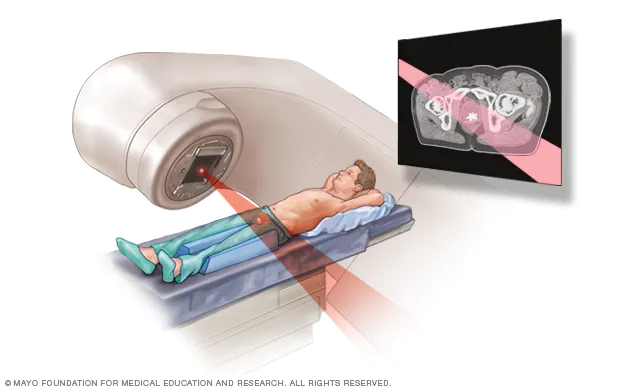Radiation Therapy for Prostate Cancer: Understanding Options, Side Effects, and Advances in Treatment
Prostate cancer is one of the most common cancers in men, and there are several treatment options available depending on the stage and aggressiveness of the disease. Radiation therapy is a cornerstone of prostate cancer treatment, especially for localized or locally advanced cancers. With advancements in radiation technology, treatments have become more precise, effective, and tailored to individual patient needs. This blog will guide you through the different types of radiation therapy, their side effects, and the latest innovations, including CyberKnife radiosurgery.
Types of Radiation Therapy for Prostate Cancer
Radiation therapy uses high-energy rays or particles to kill cancer cells. It can be used as a primary treatment for prostate cancer, as an adjunct to surgery, or to manage cancer that has returned or spread. Here are the main types of radiation therapy for prostate cancer:
1. External Beam Radiation Therapy (EBRT): EBRT is the most common form of radiation therapy for prostate cancer. It involves directing high-energy rays at the prostate from outside the body using a linear accelerator. Advances in EBRT have led to more targeted techniques, such as:
- Intensity-Modulated Radiation Therapy (IMRT): IMRT allows oncologists to shape and modulate the radiation beams more precisely to
the contours of the prostate, minimizing exposure to surrounding healthy tissues like the bladder and rectum. - Stereotactic Body Radiation Therapy (SBRT): SBRT, including CyberKnife radiosurgery, delivers highly focused radiation in fewer
sessions with extreme precision. This approach allows for a higher dose of radiation in a shorter time frame, often over just five
sessions, compared to the 20-40 sessions required for conventional EBRT.
2. Brachytherapy (Internal Radiation Therapy): Brachytherapy involves placing radioactive seeds directly into or near the prostate, allowing for a high radiation dose to the prostate while minimizing exposure to surrounding tissues. There are two main types:
- Low-Dose Rate (LDR) Brachytherapy: Small radioactive seeds are implanted in the prostate and left in place to release radiation
over several weeks or months. - High-Dose Rate (HDR) Brachytherapy: Temporary radioactive sources are placed in the prostate for a few minutes at a time over
several sessions, delivering a higher dose of radiation in a shorter period.
3. Proton Therapy: Proton therapy is a newer form of radiation that uses protons instead of traditional X-rays. It offers a more precise delivery of radiation, which reduces damage to surrounding healthy tissues. While promising, proton therapy is not widely available and may be reserved for specific cases.
CyberKnife Radiosurgery – A Revolutionary Option for Prostate Cancer
One of the most innovative and exciting advancements in radiation therapy for prostate cancer is CyberKnife radiosurgery. Despite its name, CyberKnife is not a surgical procedure but a highly advanced form of SBRT. It uses a robotic arm to deliver precise, high-dose radiation beams to the prostate from multiple angles, allowing for pinpoint accuracy.
Key Benefits of CyberKnife Radiosurgery:
Extreme Precision: The CyberKnife system continuously tracks the movement of the prostate during treatment, adjusting in real-time for any shifts caused by breathing or bladder filling, ensuring the radiation is always accurately targeted.
Shorter Treatment Duration: CyberKnife typically requires only 1-5 sessions, significantly reducing the overall treatment time compared to conventional radiation therapies.
Minimized Side Effects: Due to its precision, CyberKnife radiosurgery minimizes radiation exposure to surrounding tissues, reducing the risk of common side effects like urinary and bowel issues.
Non-Invasive: The procedure is completely non-invasive, with no incisions or anaesthesia required, making it a convenient option for patients who prefer to avoid surgery.
CyberKnife radiosurgery is an excellent option for patients with early-stage, localized prostate cancer who seek an effective treatment with fewer side effects and a quicker recovery time. It is also being used for patients who may not be candidates for surgery due to other health conditions.
Side Effects of Radiation Therapy for Prostate Cancer and How to Manage Them
While radiation therapy is effective in treating prostate cancer, it can also cause side effects. These can vary depending on the type of radiation, the dose, and the individual patient’s health. Common side effects include –
Urinary Issues: Many patients experience urinary symptoms such as increased frequency, urgency, or discomfort. In some cases, radiation can cause urinary incontinence or a weaker urine stream. Staying well-hydrated, avoiding caffeine and alcohol, and using prescribed medications can help manage these symptoms.
Bowel Problems: Radiation therapy may irritate the rectum, causing diarrhoea, rectal bleeding, or discomfort. Eating a low-fibre diet and using medications to manage diarrhoea can help reduce these symptoms.
Erectile Dysfunction: Radiation can affect nerves and blood vessels that are essential for erections. While erectile function may gradually return, some patients might need medications or other interventions to help manage this side effect.
Fatigue: Fatigue is a common side effect that can last for several weeks or months after treatment. Staying active, maintaining a balanced diet, and getting plenty of rest can help manage fatigue.
Advances in Radiation Oncology: Enhancing Precision and Reducing Side Effects
Technological advancements have significantly improved radiation therapy’s precision and effectiveness for prostate cancer. Techniques like Image-Guided Radiation Therapy (IGRT) use advanced imaging during each treatment session to ensure precise targeting of the prostate. Adaptive Radiation Therapy involves modifying the treatment plan as needed, based on changes in the patient’s anatomy or tumor size over time, further reducing side effects and enhancing outcomes.
CyberKnife radiosurgery and proton therapy represent the forefront of radiation oncology, providing options that maximize treatment efficacy while minimizing damage to healthy tissues. As research continues, these innovative treatments are likely to become more widely available, offering new hope to patients with prostate cancer.
Conclusion: Making an Informed Decision About Radiation Therapy for Prostate Cancer
Choosing the right radiation therapy for prostate cancer can be a daunting decision, but understanding the available options and their potential benefits and side effects is crucial. Whether you opt for traditional external beam radiation, brachytherapy, proton therapy, or cutting-edge CyberKnife radiosurgery, it’s essential to have an open discussion with your healthcare team to determine the best approach for your unique health situation.
By staying informed about the latest advancements in radiation oncology, you can make confident, well-informed decisions about your treatment, enhancing your chances of a successful outcome and maintaining your quality of life throughout your cancer journey. Remember, you are not alone—support is available from medical professionals, patient advocacy groups, and loved ones to help guide you through this process.

Dr. Mahadev Potharaju Senior Consultant-Radiation Oncology





.png)




